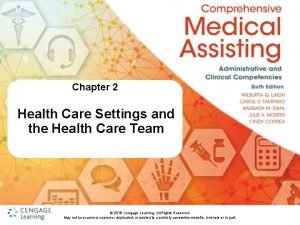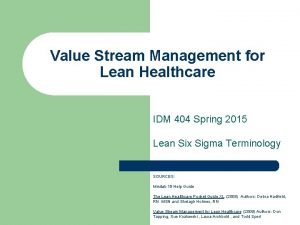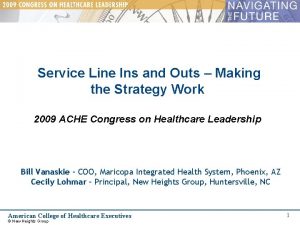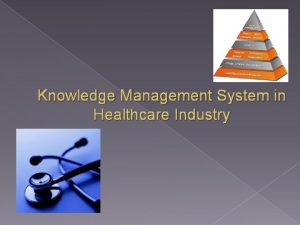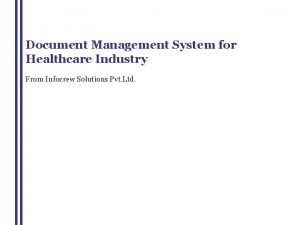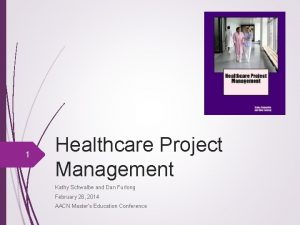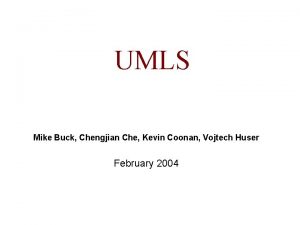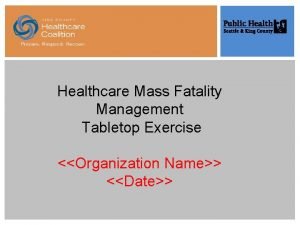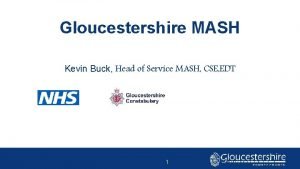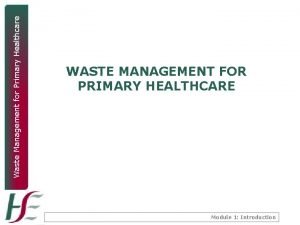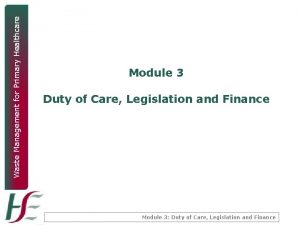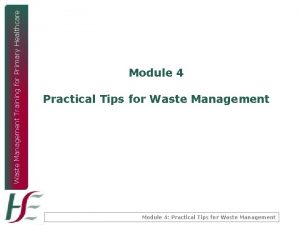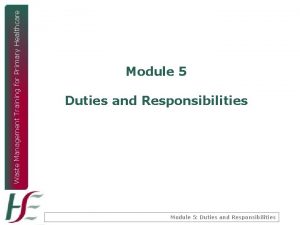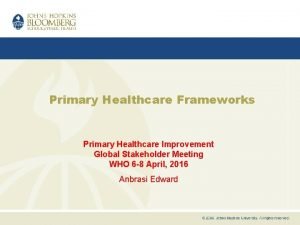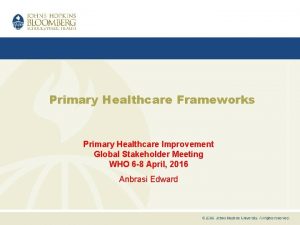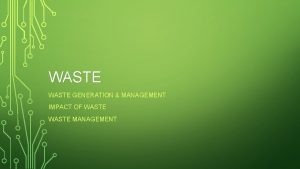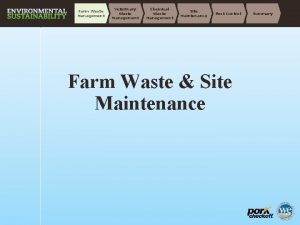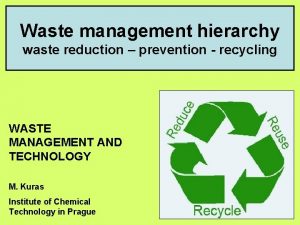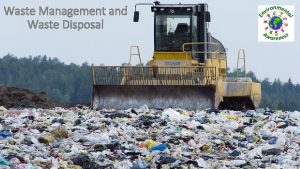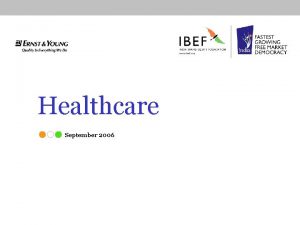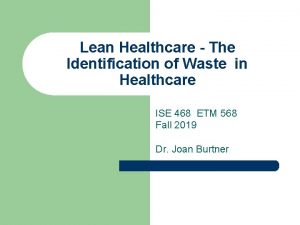Waste Management for Primary Healthcare Module 2 Waste




















- Slides: 20

Waste Management for Primary Healthcare Module 2 Waste Management Overview Module 2: Waste Management Overview

Waste Management for Primary Healthcare Objectives • You will learn in this section: – What is healthcare waste – Why it is important to effectively manage healthcare waste? Module 2: Waste Management Overview

Waste Management for Primary Healthcare (1) What Constitutes Healthcare Waste • Primary healthcare facilities & functions produce a very wide range of wastes • Waste is generated in – kitchens/canteens, wards, office waste, and Health centres etc. – Different techniques are employed to handle and treat this waste depending on its characteristics • Broadly, healthcare waste can be categorised as ‘Risk’ or ‘Non-Risk’ Module 2: Waste Management Overview

Waste Management for Primary Healthcare 1. 1 Healthcare Non-risk waste Waste Category Definition Example Municipal waste Includes normal household and catering waste, all non-infectious waste, non-toxic, non-radioactive waste and non-chemical waste Confidential material Includes shredded waste documents of a confidential nature Black plastic bags from canteen Shredded records, invoices and other statements from primary healthcare offices Module 2: Waste Management Overview

Waste Management for Primary Healthcare 1. 1 Healthcare Non-risk waste Waste Category Definition Example Medical equipment Assessed as noninfectious, i. e. not contaminated with blood or hazardous body fluids Plastic bottles, plastic packaging, dialysis machines and other Waste Electrical and Electronic Equipment (WEEE) Potentially offensive material Assessed as noninfections, i. e. not contaminated with blood or hazardous body fluids Nappies/incontinence wear, stoma bags, etc. Module 2: Waste Management Overview

Waste Management for Primary Healthcare 1. 2 Healthcare Risk Waste • Healthcare risk waste is any waste that is classified as hazardous, or is mixed or contaminated with hazardous waste. • Most commonly, healthcare risk waste is classified as hazardous or dangerous due to the risk of it being infectious or because it contains used sharp materials that could cause injury. Module 2: Waste Management Overview

Waste Management for Primary Healthcare 1. 2 Healthcare Risk Waste Definition Category General a) Blood and items visibly soiled with blood b) Contaminated waste from patients with transmissible infectious diseases c) Incontinence wear/nappies from patients with known or suspected enteric pathogens Example Bandages, incontinence wear/nappies from patients with known or suspected enteric pathogens Salmonella d) Items contaminated with body fluids other than faeces, urine or breast milk e) Other healthcare infectious waste E Coli Module 2: Waste Management Overview

Waste Management for Primary Healthcare 1. 2 Healthcare Risk Waste Category Laboratory Waste Definition f) Specimens and potentially infectious waste from pathology departments Example Potentially infectious samples and specimens and used laboratory equipment such as contaminated containers, test tubes, slides etc. Teeth, organs, foetal remains g) Microbiological cultures (liquid or solid media in which organisms have been artificially cultivated) Biological h) Other laboratory waste i) Anatomical waste and identifiable body parts Module 2: Waste Management Overview

Waste Management for Primary Healthcare 1. 2 Healthcare Risk Waste Category Sharps Definition j) Any object which has been used in the diagnosis, treatment or prevention of disease that is likely to cause a puncture wound or cut to the skin Example Needles, syringes with needles attached, broken glass ampoules, scalpel and other blades, and infusion sets (the sharps part thereof) Module 2: Waste Management Overview

Waste Management for Primary Healthcare 1. 2 Healthcare Risk Waste Category Radioactive waste Toxic waste Definition Example k) Includes materials in excess of authorised clearance levels, classified as radioactive under the General control of Radioactive Substances Order, 1993 (S. I. No. 151 of 1993) Radionuclides used in therapeutic and diagnostic medicine l) Discarded hazardous chemicals, reagents and medicines Cytotoxic and cytostatic chemicals Module 2: Waste Management Overview

Waste Management for Primary Healthcare 1. 3 EWC Codes § EWC = European Waste Catalogue § EWC codes are used for the classification of all wastes and hazardous wastes § Each waste is given a six-digit code for the waste § It’s consistent across the EU § Asterisk (*) = hazardous § EWC available at www. environ. ie Module 2: Waste Management Overview

Waste Management for Primary Healthcare 1. 3 EWC Codes • A few examples - healthcare EWC codes: – 18 01 01 Sharps – 18 01 04 Wastes whose collection and disposal is not subject to special requirements in order to prevent infection (for example dressings, plaster casts, linen, disposable clothing, diapers) – 18 01 06* Chemicals consisting of or containing dangerous substances – 18 01 10* amalgam waste from dental care Module 2: Waste Management Overview

Waste Management for Primary Healthcare 1. 3 EWC Codes • In the EWC, waste is categorised into 20 Chapters according to the processes/industry the waste arises from • Chapter 18 is the main chapter for healthcare waste – “Wastes from human or animal health care and/or related research (except kitchen and restaurant wastes not arising from immediate health care)” • Check with your Waste Manager if you need to know a waste code, or need to complete any related paperwork Module 2: Waste Management Overview

Waste Management for Primary Healthcare 1. 3 EWC Codes • The Waste Management Acts 1996 to 2005 do not give an exhaustive list of materials that are considered to be waste. • A full comprehensive list reference should be made to the European Waste Catalogue. • The list also incorporates hazardous waste materials and can be downloaded from www. environ. ie. • The EWC categorises waste into 20 Chapters according to processes from which the waste arises e. g. – Chapter 18 – “Wastes from human or animal health care and/or related research (except kitchen and restaurant wastes not arising from immediate health care)” Module 2: Waste Management Overview

Waste Management for Primary Healthcare (2) Waste Management – National Statistics Module 2: Waste Management Overview

Waste Management for Primary Healthcare 2. 1 General Waste Management Statistics – In 2007 the generation of municipal waste increased by 0. 4% to 3, 397, 683 tonnes (EPA, 2009) Module 2: Waste Management Overview

Waste Management for Primary Healthcare 2. 1 General Waste Management Statistics – The recycling of municipal waste increased by 3% to an overall recycling rate of 36%. The disposal of municipal waste to landfill also increased by 2%. Module 2: Waste Management Overview

Waste Management for Primary Healthcare 2. 1 General Waste Management Statistics – Recycling of packaging waste increased by 14% to 671, 630 tonnes, a recycling rate of 63. 6%, which compares well to the EU target for 2011 of 60% recycling. – The generation of hazardous waste increased by 7% to 304, 941 tonnes. Module 2: Waste Management Overview

Waste Management for Primary Healthcare 2. 2 Healthcare Waste Statistics • 9, 475 tonnes of healthcare risk waste was produced in 2007 – of this, 8, 985 tonnes was treated in Ireland 473 tonnes was exported (EPA, 2009) Module 2: Waste Management Overview

Waste Management for Primary Healthcare End of Module 2: Waste Management Overview
 Healthcare and the healthcare team chapter 2
Healthcare and the healthcare team chapter 2 Sports medicine meaning
Sports medicine meaning Lean waste in healthcare
Lean waste in healthcare Uhc medication prior authorization form
Uhc medication prior authorization form C device module module 1
C device module module 1 Value stream management for lean healthcare
Value stream management for lean healthcare Service line strategy
Service line strategy Knowledge management systems in healthcare
Knowledge management systems in healthcare Dms for the healthcare industry
Dms for the healthcare industry Healthcare project management kathy schwalbe
Healthcare project management kathy schwalbe Kevin buck healthcare change management
Kevin buck healthcare change management Fatality management for healthcare
Fatality management for healthcare Kevin mash
Kevin mash Fspos vägledning för kontinuitetshantering
Fspos vägledning för kontinuitetshantering Typiska drag för en novell
Typiska drag för en novell Tack för att ni lyssnade bild
Tack för att ni lyssnade bild Returpilarna
Returpilarna Varför kallas perioden 1918-1939 för mellankrigstiden?
Varför kallas perioden 1918-1939 för mellankrigstiden? En lathund för arbete med kontinuitetshantering
En lathund för arbete med kontinuitetshantering Kassaregister ideell förening
Kassaregister ideell förening Personlig tidbok för yrkesförare
Personlig tidbok för yrkesförare
